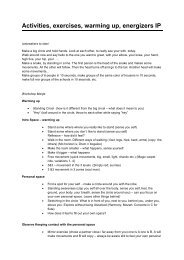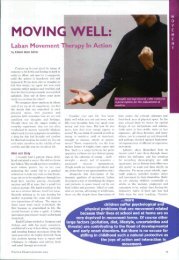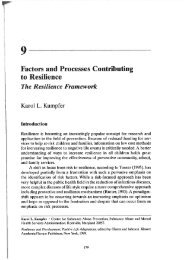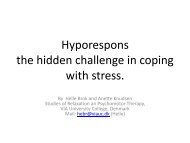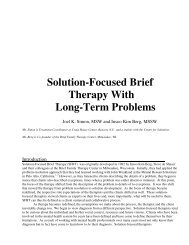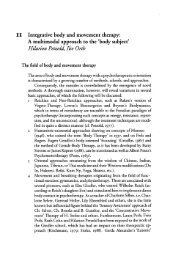Psychomotor therapy for patients with stress-related complaints
Psychomotor therapy for patients with stress-related complaints
Psychomotor therapy for patients with stress-related complaints
Create successful ePaper yourself
Turn your PDF publications into a flip-book with our unique Google optimized e-Paper software.
<strong>Psychomotor</strong> <strong>therapy</strong> <strong>for</strong><br />
<strong>patients</strong> <strong>with</strong> <strong>stress</strong>-<strong>related</strong><br />
<strong>complaints</strong><br />
A cognitive-behavioral approach<br />
Olivier Glas<br />
Teacher at HAN-university<br />
<strong>Psychomotor</strong> therapist at Kairos (<strong>for</strong>ensic psychiatry)
Some basic assumptions<br />
Human beings are <strong>related</strong> to the world by<br />
their bodies and movement.<br />
Movement-behavior should always been<br />
seen in relation to the context their moving<br />
in.<br />
Movement behavior, cognitions and<br />
emotions are interacting <strong>with</strong> each other
Patients <strong>with</strong> <strong>stress</strong> & anxiety<br />
CBT: problematic behaviour is learned<br />
CBT: Healthy behavior can be learned also<br />
Complaints <strong>related</strong> to <strong>stress</strong> & anxiety have<br />
their origin in a problematic way of dealing<br />
<strong>with</strong> emotions.<br />
The way of dealing <strong>with</strong> emotions is<br />
influenced by cognitions and<br />
(movement)behaviour
In terms of DSM-IV<br />
All anxiety and mood disorders (except<br />
PTSD)<br />
Somato<strong>for</strong>m disorders<br />
Substance <strong>related</strong> disorders (?)<br />
Impuls-control disorder (i.p. agression) (?)
The model of David H. Barlow<br />
How a CBT-model can be used as a<br />
theoretical frame <strong>for</strong> PMT…..<br />
A model that makes the patient responsible<br />
<strong>for</strong> its own behavior, emotions and thoughts<br />
The importance of doing something else<br />
than the psychotherapist
Negative affect<br />
(emotion, sensation, thought)<br />
Tadaaa!!!!!<br />
Judged Attempt to Fails<br />
as unbearable supress or avoid<br />
Judged No supressing Recovery<br />
as bearable or avoiding in a<br />
natural<br />
way<br />
Campell-Sills, L., Barlow, D.H., Brown, T.A. & Hofmann, S.G. (in preparation).<br />
Appraisal and regulation in anxiety and mood disorders.
What should I (as a psychomotor therapist)……….<br />
………..do <strong>with</strong> this???<br />
Observe very well (posture, tension and<br />
movement) in context!<br />
Try to understand movement-behavior in<br />
terms of the model<br />
Name the opposite and incompatible<br />
movement-behavior<br />
Find the way to work towards the<br />
incompatible movement-behavior<br />
Relaxation, exercise, fitness and increasing<br />
tension
An other useful model<br />
Expressional<br />
Sensoric Motoric<br />
Impressional<br />
Self Other<br />
Hekking & Fellinger, 2003
An example……



